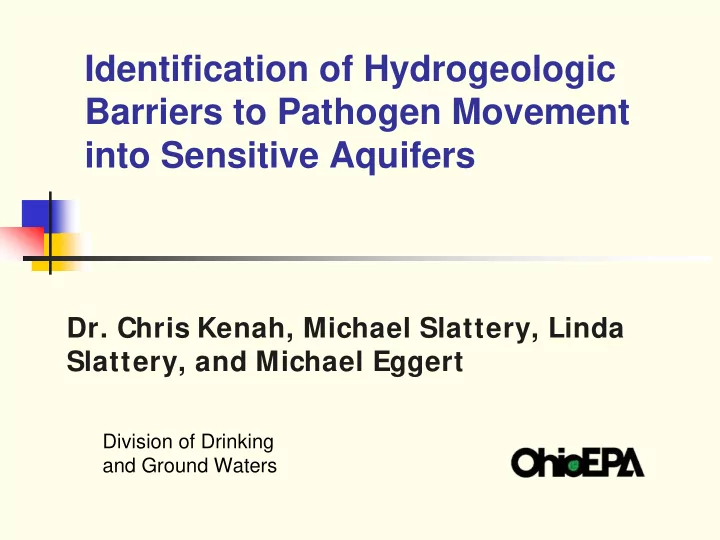

Identification of Hydrogeologic Barriers to Pathogen Movement into Sensitive Aquifers Dr. Chris Kenah, Michael Slattery, Linda Slattery, and Michael Eggert Division of Drinking and Ground Waters
Outline � Purpose of Hydrogeologic Barrier Study; � Describe Ohio sensitive aquifers; � Results of Hydrogeologic Barrier Study; � Implications for implementation of Ground Water Rule.
Hydrogeologic Barrier Study Study Purpose - Determine whether hydrogeologic barriers to pathogen movement exist for sensitive aquifers, as defined in the proposed, Federal GW Rule.
Hydrogeologic Barrier Hydrogeologic barrier definition: Physical, biological, and chemical factors, singularly or in combination, that prevent the movement of viable pathogens from a contaminant source to a public supply well.
Sensitive Aquifers � Proposed GW Rule: � Karst (solution enhanced fractures) � Fractured rock � Gravel considered sensitive aquifers, unless a hydrogeologic barrier is present.
Sensitive Aquifers in Ohio Two Main settings – based on water quality: � Thin drift over bedrock aquifers; � Buried valley sand and gravel aquifers. Water quality impacts may not indicate pathogen sensitivity?
Hydrogeologic Barrier Study � MDH, Ohio EPA, U.S. EPA; � Select non-vulnerable wells in sensitive settings; � Analyze for pathogen indicators; � To demonstrate presence of hydro- geologic barriers
Pathogen Indicators � Coliform Bacteria � E. Coli Bacteria � Enterococci Bacteria � Coliphage
Aquifer Selection Criterion � Well Pumps from a Karst, Fractured Rock, or Gravel Aquifer � Protective Geologic Cover Present � Potential Pathogen Source Nearby � Lateral Pathway Not Likely Present
Well Selection Criteria � Well Construction Record Available � Well Met Construction Standards � No Recent History of Bacterial Contamination � Owner Consent to Participate
Ohio’s Selected Wells � Sand and Gravel Hydrogeologic Barrier � 23 wells, 3 confined, 1 Ranney well; � Casing length: 27 - 182 feet; � Glacial Drift Hydrogeologic Barrier � 9 wells, 2 tritium non-detect; � Casing length: 39 - 100 feet;
Microbiological Sampling Results � 5-9 quarters of sampling completed for 32 wells, 244 samples collected; � 10 samples with detections from 8 sites: � Two total coliform positive sites with fecal contamination (Enterococci, 1 false positive); � Two sites with two TC+ results; � Six sites with 1 TC + with no positive fecal indicators; (3 of the 6 attributed to sample contamination or distribution issues).
Microbiological Sampling Results � Generally sand and gravel aquifers did not exhibit pathogen sensitivity. � Except for wells in floodplains during flooding. � One site in thin till exhibited two TC+ detections.
DATA ANALYSIS Use data to evaluate correlations of limited results: � Determine well attributes that may correlate to indicator presence (casing length, static water…) � Identify the hydrogeologic barrier attributes where no detections occurred in the source water. � Goal – to refine selection criteria for identifying hydrogeologic barriers.
Study Findings � No ground water samples tested positive for E. coli , male specific coliphage, or somatic coliphage. � No unexplained pathogen indicators were detected where a saturated, clay-rich barrier is present.
Study Findings � Pathogen detections occurred in: � S&G wells in flood plains; � Detections associated with flooding and horizontal flow paths � Fractured bedrock wells below thin drift. � Concept of a hydrogeologic barrier appears to be sound.
Implications for GW Rule � Study confirms that hydrogeologic barriers protect wells in sensitive aquifers; � Data suggests clay-rich thickness and saturated casing length are useful parameters for identifying hydrogeologic barriers; � Horizontal flow paths need to be identified in hydrogeologic sensitivity assessment;
Implications for GW Rule � GW Rule implementation focus on PWSs vulnerable to pathogens; � Use pathogen detection data from raw water samples to refine hydro-geologic barrier definition; � Provides focus on public health protection while collecting data to target additional sampling in cost effective manner.
Acknowledgments & Information Grant Activities � Pathogen analysis completed by MDH Lab; � Analysis paid for by U.S.EPA; � Conclusions from Hydrogeologic Barrier Study, completed by MDH and Ohio EPA staff. Additional Information on GW Rule: http://www.epa.gov/safewater/disinfection/gwr/index.html christopher.kenah@epa.state.oh.us
Recommend
More recommend